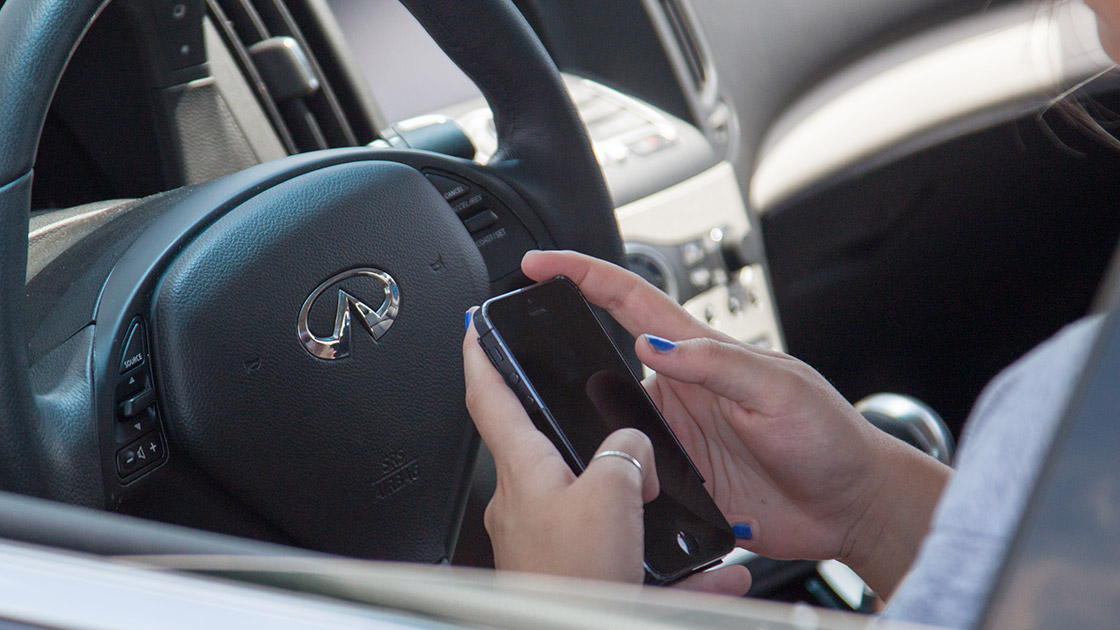Large naturalistic study provides new window on driver distraction
December 10, 2015

Figuring out the role cellphone use and other distracting behaviors play in crashes is a challenge for researchers. While things like driver age and alcohol impairment are fairly easy to establish after a serious crash, distraction is harder to pin down. In most cases, there is no reliable record of what a driver was doing in the moments leading up to a collision.
To get a handle on the role of distraction in crashes, researchers often turn to naturalistic driving studies, in which a group of drivers are continuously monitored over an extended time period. An IIHS analysis of data from a recent large naturalistic study provides new evidence that using cellphones, eating or drinking, and interacting with an in-vehicle system all increase the odds of a crash. At the same time, the analysis shows the need to consider crash severity when using these data to estimate crash risk.
The data are from the second Strategic Highway Research Program, known as SHRP2. More than 3,000 drivers were monitored for up to three years during 2010-13. Footage of normal driving was collected, along with video of all crashes and the moments leading up to them.
SHRP2 is a multifaceted research initiative conducted under the auspices of the American Association of State Highway and Transportation Officials, the Federal Highway Administration and the National Research Council.
The SHRP2 study dwarfs previous sources of naturalistic driving data. An earlier one used in IIHS research monitored 105 drivers for a year during 2003-04. Few crashes were observed in that study, so IIHS researchers looked at crashes together with "near crashes," such as hard braking or evasive maneuvers.
It's open to question just how similar near-crash situations are to actual crashes.The SHRP2 data include enough actual collisions that, for the first time, including near crashes isn't necessary. At the same time, the 1,465 crashes recorded in the SHRP2 study vary in severity. Not surprisingly, the least severe crashes are the most common. And when IIHS researchers looked at the effect of distracting behaviors on crash risk, they discovered there are big differences depending on the severities of crashes included.
"This is a huge trove of valuable data that is adding to our understanding of driver distraction," says David Kidd, an IIHS senior research scientist and the lead author of the analysis. "However, in all the hours of driving that were monitored, there were no fatal crashes, and most of the crashes that did occur didn't involve serious injuries. That makes it hard to draw conclusions about the crashes we're most interested in — the ones that kill and injure people."
Of the crashes recorded, 42 percent are low-risk tire strikes, which include things like a tire hitting a curb or briefly going up on the curb. Most drivers likely wouldn't even consider these to be crashes and in some cases might not even notice them. Another 41 percent of the crashes are classified as minor, while 10 percent include sufficient damage to be police-reportable, and 7 percent were classified as "most severe." The most severe category includes crashes that involve an airbag deployment, injury or a high change in speed at impact.
For all of the crashes and for random six-second snippets of normal driving, researchers looked for the presence of "secondary behaviors" — activities performed by drivers in addition to driving. This allowed IIHS scientists to calculate the odds of crashing while engaged in any secondary behavior and specifically while talking on a cellphone, manipulating a cellphone, eating or drinking, or interacting with an in-vehicle system, such as temperature controls or the radio.
Relative to driving without any secondary behavior, the odds of a crash of any type were significantly higher when drivers were engaged in any secondary behavior, when they were manipulating cellphones and when they were interacting with an in-vehicle system. Talking on a cellphone and eating and drinking also raised the odds of any crash, but those results weren't significant.
Excluding low-risk tire strikes made the pattern more obvious. The odds ratios went up for every category of secondary behavior that was examined, and all were significant. Of all activities analyzed, manipulating a cellphone was associated with the biggest crash risk — about 5 times the odds of crashing while driving without any secondary behavior.
Earlier naturalistic studies also found that manipulating a cellphone increased the risk of a crash or near crash. A new finding is that simply talking on a cellphone also significantly increases the odds of a crash when tire strikes are excluded.
The rough odds ratios in this study aren't adjusted for driver characteristics or environmental factors. IIHS researchers plan to conduct follow-up analyses to take those things into account.
The study doesn't address what policies might reduce the types of distraction that lead to crashes. Earlier research by IIHS and HLDI has found that cellphone and texting bans reduce phone use, but not crashes. The researchers hypothesized that drivers who refrained from using their phones manually may have switched to hands-free systems, which also can be distracting, or may have been distracted by something else (see Status Report special issue: distracted driving, Oct. 24, 2014).
"Our understanding of the role cellphones play in crashes continues to evolve," says Anne McCartt, IIHS senior vice president for research and a co-author of the new study. "Although this study shows that manipulating a cellphone is more risky than some other secondary behaviors, it's important to remember that drivers are distracted in many other ways, and putting down the phone does not mean a driver is paying attention to the road. An approach that addresses all kinds of distraction, instead of focusing specifically on cellphones, will be most successful in improving safety."